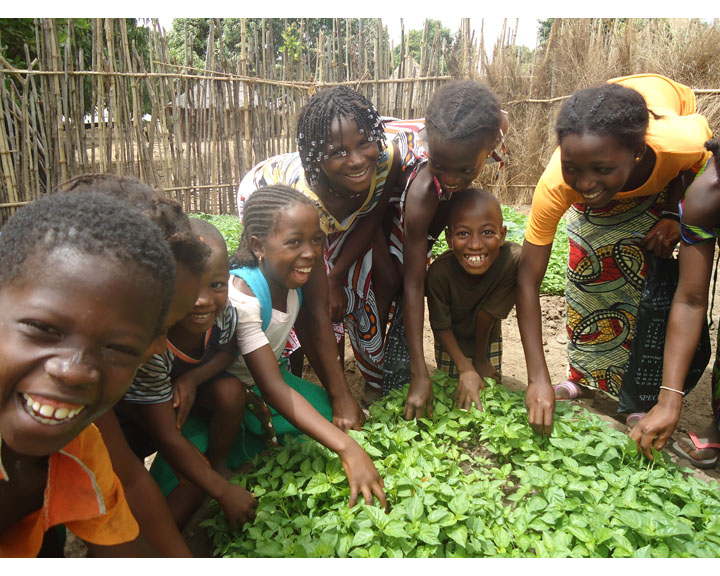

Reading, writing and tilling the soil

Children like 11-year-old Awa Sila of Guinea-Bissau grow up under difficult circumstances. A third of under-5’s in her country suffer from moderate to severe stunting and 19 % are under-weight. More than 1 in 10 die before reaching the age of 5.
But Awa and her classmates at the Dandum School, in a remote corner of southeast Guinea-Bissau, are part of a new experiment to reduce malnutrition and child mortality. Through an MDG-F-financed programme, thousands of children in the most vulnerable parts of the country are getting hands-on lessons in good nutrition: they are being taught how to cultivate school gardens, and reaping the rewards of their labour.
“All the children from my village are eating the different vegetables we plant,” says Awa, whose school is one of 150 where gardens have been planted and children are being taught about the importance of varied and healthy diets.
Motivated by what she had learned, Awa decided to bring her knowledge home and persuaded her mother, Siraboi Camara, to start a household garden.
“Everything I’ve learned in our school garden has been used in our family garden,” says Awa. Siraboi started teaching other relatives, and the produce from the household garden is now supporting both the family and their neighbours.
Schools as classrooms for nutrition
The school gardens are part of a joint United Nations programme aimed at reducing child malnutrition and mortality in Guinea-Bissau by improving the country's capacity to monitor and treat malnutrition, and by promoting better nutrition and food practices through the school gardens initiative, school meals and the distribution of educational materials.
The joint programme is providing schools like Dandum School with seeds, gardening tools and agricultural training for teachers, parents and the school community. Teachers, school cooks and parents also receive training in school garden management and on basic nutrition issues.
The programme is also training local health professionals to identify and treat malnutrition, and assisting journalists in producing nutrition-related radio messages to disseminate directly to the villages. Besides the technical training, the joint programme provides journalists with radio equipment and motorcycles to help them access remote locations such as Awa Sila’s village in Boé Sector.
Awa’s school director, Bacar Baldé, says the participation of the community, especially the families of his students, has been crucial to the success of the school garden. In 2011, Dandum school produced more than 100 kilos of tomatoes, as well as lettuce, onions, peppers, okra and other vegetables. Most importantly, says Baldé, the garden is changing habits and behaviour around nutrition.
“The income from the sale of onions is of 200.000 CFA (US $400) and it is only the beginning of the sale season!” he explains. “This income is being managed by the women of the village and it will be reinvested in the School Garden.”
Meanwhile, Awa Sila’s experience was so successful that is has been reproduced in the form of a colorful poster in English and Portugese and distributed to schools serving 25,000 children. The programme also created a food pyramid, which is printed in Portugese on a multiplication table postcard, as a handy reference to teach school children about good nutrition.
“Now I understand the importance of eating all the vegetables we plant,” says Awa. “To grow healthy, we need to eat to eat daily the three food groups.”
Reaching the most vulnerable populations
The MDG-Fund-financed Joint Programme “Promotion of a multi-level approach to child malnutrition” is a collaboration between the government of Guinea-Bissau, the NGO Caritas and four UN agencies (WFP, WHO, UNICEF and FAO). Its goal is to strengthen the country’s capacity in reducing child malnutrition and mortality, focusing on three of the most vulnerable regions in terms of child malnutrition and child mortality rates.
The programme is part of the MDG-F’s effort to help countries like Guinea-Bissau to reach the Millennium Development Goals, including reducing poverty and improving child and maternal health, with a particular focus on reaching the most disadvantaged and vulnerable populations.
At the end of the 3-year joint programme, at least 25,000 school children will have been reached in 150 communities through school garden activities, and 30,000 families will have learned good nutrition and feeding practices to prevent malnutrition.